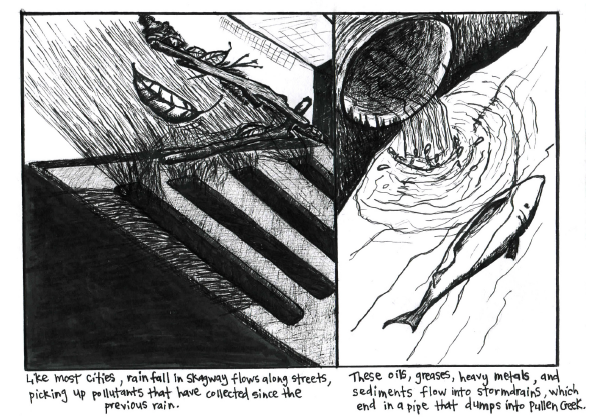Clean water and bountiful salmon are an integral part of life in Southeast Alaska, where our wet rainforest climate creates the conditions to support the thriving rivers, streams, and ocean our communities depend on. While we live, work, and recreate in this beautiful corner of the world, the activities of our daily lives can result in impacts to the aquatic environments we hold so near and dear to our hearts. Taiya Inlet Watershed Council in Skagway is introducing a model solution to city pollution in one of their most popular streams.
Stormwater Pollution in Urban Areas
As rainfall and melted snow accumulate and move across the nonporous surfaces of our urban areas like sidewalks and city streets, they collect pollutants such as motor oil, gasoline, fertilizers, pesticides, heavy metals, and excess sediments. These pollutants wash into our city storm drains which often lead directly to nearby streams or ocean. When our stormwater is deposited into our waterways it can negatively affect water quality within the waterbody, making it difficult for fish and other aquatic organisms to thrive and reproduce in these waters.

How can communities reduce stormwater pollution?
One of the most practical solutions is to direct the stormwater into soil, where it can soak into the ground. The pollutants are captured by the soils and the plants growing in the area. Assuming no one eats those plants, they stay contained in a controlled area.
The idea of a rain garden is to capture rain water and snowmelt either before it hits the streets or before it hits the stormdrain, naturally filtering out contaminants through specifically chosen soils and plants.

With funding from the Alaska Department of Environmental Conservation’s Alaska Clean Water Actions program, the Taiya Inlet Watershed Council is introducing the concept of a rain garden to the community of Skagway through a demonstration garden and spring workshop.
TIWC has put together a handbook on “Why and How to Build Rain Gardens”, using Skagway’s Pullen Creek as a model to demonstrate the importance of proper stormwater management.
View and download the handbook below, and be sure to check out TIWC’s Pullen Creek rain garden project on their website!
